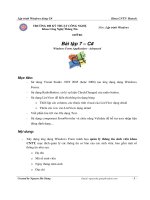Advanced Graphics
Bạn đang xem bản rút gọn của tài liệu. Xem và tải ngay bản đầy đủ của tài liệu tại đây (83.08 KB, 8 trang )
83
source. See the online document Using MATLAB
Graphics for camera and lighting help.
This example defines the color, shading, lighting, surface
material, and viewpoint for the cover of the book:
axis off
axis equal
colormap(hsv(1024))
shading interp
material shiny
lighting gouraud
lightangle(80, -40)
lightangle(-90, 60)
view([-150 10])
14. Advanced Graphics
MATLAB possesses a number of other advanced
graphics capabilities. Significant ones are bitmapped
images, object-based graphics, called Handle Graphics®,
and Graphical User Interface (GUI) tools.
14.1 Handle Graphics
Beyond those just described, MATLAB’s graphics
system provides low-level functions that let you control
virtually all aspects of the graphics environment to
produce sophisticated plots. The commands
set
and
get
allow access to all the properties of your plots. Try
set(gcf)
to see some of the properties of a figure that
you can control.
set(gca)
lists the properties of the
current axes (see Section 14.3 for an example). This
system is called Handle Graphics. See Using MATLAB
Graphics for more information.
84
14.2 Graphical user interface
MATLAB’s graphics system also provides the ability to
add sliders, push-buttons, menus, and other user interface
controls to your own figures. For information on creating
user interface controls, try
doc
uicontrol
. This allows
you to create interactive graphical-based applications.
Try
guide
(short for Graphic User Interface
Development Environment). This brings up MATLAB’s
Layout Editor window that you can use to interactively
design a graphic user interface. Also see the online
document Creating Graphical User Interfaces.
14.3 Images
The
image
function plots a matrix, where each entry in
the matrix defines the color of a single pixel or block of
pixels in the figure.
image(K)
paints the (i,j)th block of
the figure with color
K(i,j)
taken from the
colormap
.
Here is an example of the Mandelbrot set. The bottom
left corner is defined as
(x0,y0)
, and the upper right
corner is
(x0+d,y0+d)
. Try changing
x0
,
y0
, and
d
to
explore other regions of the set (
x0=-.38
,
y0=.64
,
d=.03
is also very pretty). This is also a good example
of one-dimensional indexing:
x0 = -2 ; y0 = -1.5 ; d = 3 ; n = 512 ;
maxit = 256 ;
x = linspace(x0, x0+d, n) ;
y = linspace(y0, y0+d, n) ;
[x,y] = meshgrid(x, y) ;
C = x + y*1i ;
Z = C ;
K = ones(n, n) ;
for k = 1:maxit
a = find((real(Z).^2 + imag(Z).^2) < 4);
Z(a) = (Z(a)).^2 + C(a) ;
K(a) = k ;
85
end
figure(1) ; clf
colormap(jet(maxit)) ;
image(x0 + [0 d], y0 + [0 d], K) ;
set(gca, 'YDir', 'normal') ;
axis equal
axis tight
image
, by default, reverses the y direction and plots the
K(1,1)
entry at the top left of the figure (just like the
spy
function described in Section 15.5). The
set
function resets this to the normal direction, so that
K(1,1)
is plotted in the bottom left corner.
Try replacing the fourth argument in
surf
, for the
seashell example, with
K
, to paint the seashell surface
with the Mandelbrot set.
15. Sparse Matrix Computations
A sparse matrix is one with mostly zero entries.
MATLAB provides the capability to take advantage of
the sparsity of matrices.
15.1 Storage modes
MATLAB has two storage modes, full and sparse, with
full the default. Currently, only
double
or
logical
vectors or two-dimensional arrays can be stored in the
sparse mode. The functions
full
and
sparse
convert
between the two modes. Nearly all MATLAB operators
and functions operate seamlessly on both full and sparse
matrices. For a matrix
A
, full or sparse,
nnz(A)
returns
the number of nonzero elements in A. An
m
-by-
n
sparse
matrix is stored in three or four one-dimensional arrays.
For a real sparse matrix, numerical values and their row
indices are stored in two arrays of size
nnzmax(A)
each,
but only the first
nnz(A)
entries are used (complex
86
matrices use three arrays). All entries in any given
column are stored contiguously and in sorted order. A
third array of size
n+1
holds the positions in the other two
arrays of the first nonzero entry in each column. Thus, if
A
is sparse, then
x=A(9,:)
takes much more time than
x=A(:,9)
, and
s=A(4,5)
is also slow. To get high
performance when dealing with sparse matrices, use
matrix expressions instead of
for
loops and vector or
scalar expressions. If you must operate on the rows of a
sparse matrix
A
, work with the columns of
A'
instead.
If a full tridiagonal matrix
F
is created via, say,
F = floor(10 * rand(6))
F = triu(tril(F,1), -1)
then the statement
S=sparse(F)
will convert
F
to sparse
mode. Try it. Note that the output lists the nonzero
entries in column major order along with their row and
column indices because of how sparse matrices are
stored. The statement
F=full(S)
returns
F
in full
storage mode. You can check the storage mode of a
matrix
A
with the command
issparse(A)
.
15.2 Generating sparse matrices
A sparse matrix is usually generated directly rather than
by applying the function
sparse
to a full matrix. A
sparse banded matrix can be easily created via the
function
spdiags
by specifying diagonals. For example,
a familiar sparse tridiagonal matrix is created by:
m = 6 ;
n = 6 ;
e = ones(n,1) ;
d = -2*e ;
T = spdiags([e d e], [-1 0 1], m, n)
87
Try it. The integral vector
[-1 0 1]
specifies in which
diagonals the columns of
[e d e]
should be placed (use
full(T)
to see the full matrix
T
and
spy(T)
to view
T
graphically). Experiment with other values of
m
and
n
and, say,
[-3 0 2]
instead of
[-1 0 1]
. See
doc
spdiags
for further features of
spdiags
.
The sparse analogs of
eye
,
zeros
, and
rand
for full
matrices are, respectively,
speye
,
sparse
, and
sprand
.
The
spones
and
sprand
functions take a matrix
argument and replace only the nonzero entries with ones
and uniformly distributed random numbers, respectively.
sparse(m,n)
creates a sparse zero matrix.
sprand
also
permits the sparsity structure to be randomized. This is a
useful method for generating simple sparse test matrices,
but be careful. Random sparse matrices are not truly
“sparse” because they experience catastrophic fill-in
when factorized. Sparse matrices arising in real
applications typically do not share this characteristic.
3
The versatile function
sparse
also permits creation of a
sparse matrix via listing its nonzero entries:
i = [1 2 3 4 4 4] ;
j = [1 2 3 1 2 3] ;
s = [5 6 7 8 9 10] ;
S = sparse(i, j, s, 4, 3)
full(S)
The last two arguments to
sparse
in the example above
are optional. They tell
sparse
the dimensions of the
matrix; if not present, then
S
will be
max(i)
by
max(j)
.
If there are repeated entries in
[i j]
, then the entries are
3









